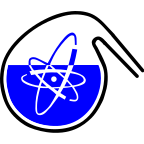Speaker
Description
Separation of minor actinides (MA, i.e. americium, curium and neptunium) from the highly radioactive raffinate originating from spent nuclear fuel reprocessing, followed by an efficient transmutation of Am could contribute to a significant decrease of the long-term radiotoxicity and heat load of vitrified highly radioactive waste (1).
The effect of 60Co gamma radiation on two different solvents was investigated; (i) 0.05 M N,N,N’,N’-tetraoctyl diglycolamide (TODGA) in the ionic liquid methyl-trioctylammonium nitrate ([N1888][NO3]) and (ii) 0.01 M 2,9-bis(5,5,8,8-tetramethyl-5,6,7,8-tetrahydro-1,2,4-benzotriazin-3-yl)-1,10-phenanthroline (CyMe4BTPhen) in [N1888][NO3].
In the first system, TODGA showed similar degradation pathways (cleavage of bonds within the DGA core of the molecule) as identified in former studies using aliphatic hydrocarbon diluents (2). The main degradation products N,N-dioctylamide, dioctylacetamide, dioctylglycolamide and dioctylformamide were identified by ultra-high performance liquid chromatography coupled to an electrospray-ionization accurate mass-mass spectrometer (UHPLC-ESI-am-MS). The residual TODGA concentration of the solvent after 1 MGy absorbed dose was found to be ca. 45 %, suggesting a high stability of the ligand when diluted in the ionic liquid [N1888][NO3].
The second system, composed of CyMe4BTPhen in [N1888][NO3] was irradiated up to an absorbed dose of 400 kGy. UHPLC-ESI-am-MS analyses showed the presence of a single ligand degradation product, an adduct formed between CyMe4BTPhen and the [N1888]+ cation. In our study, the residual concentration of CyMe4BTPhen was higher than 80 % after 100 kGy of absorbed gamma dose. Nitric acid showed a sensitization effect on the ligand in [N1888][NO3]. Former irradiation studies in 1-octanol showed a protective effect of HNO3 on the ligand (3).
The results of this study show that the sensitivity of these well-known ligands towards radiation-induced degradation can be mitigated by a proper choice of the diluent.

